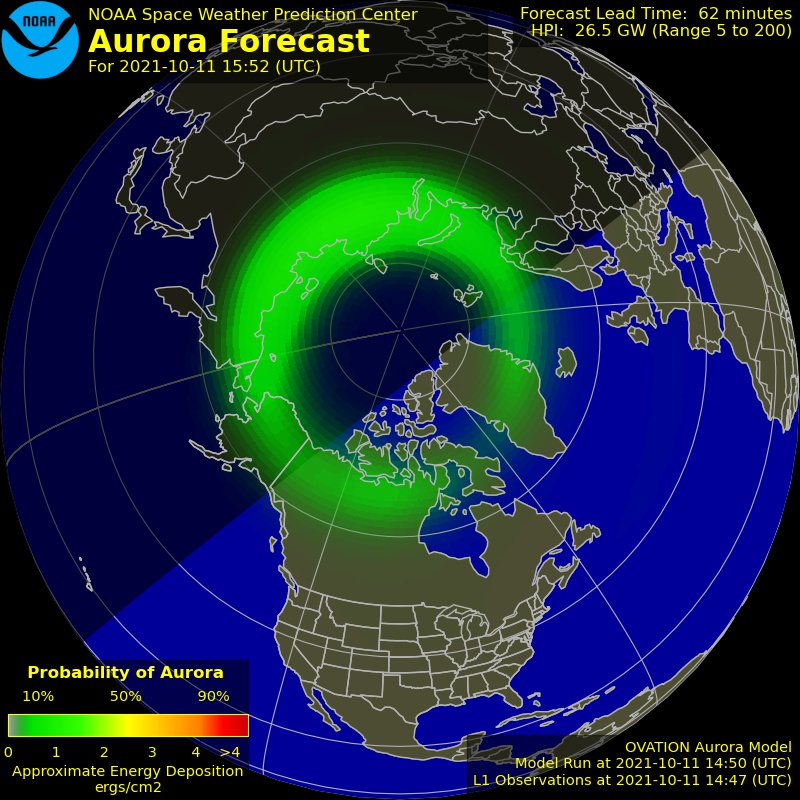
Just as predicted, a major solar flare will hit the Earth on Monday as the result of a geomagnetic storm caused by activity on the surface of the Sun.
The US National Oceanic and Atmospheric Administration issued an alert today which warned the geomagnetic storm could cause power grid fluctuations with voltage alarms at higher latitudes, where the Earth is more exposed.
As well as causing disruptions to the world’s power supply and navigation systems, which are powered by satellites, one positive aspect of the solar flares will be an appearance of the Northern Lights as far south as New York City.
Astronomers noticed the flare, or Coronal Mass Ejection, occur on Saturday, on the side of the sun that is now facing Earth. This orientation enables solar flares to have a direct impact on our satellites, power grids and electronics of all kinds, as the electromagnetic forces expelled by the flare hit the upper reaches of the Earth’s atmosphere.
According to the NOAA statement, power grid fluctuations will occur which may even result in voltage alarms in the higher latitudes of the Earth, in the northern hemisphere, where there is direct exposure to the flares.
Satellites, on which we depend for telecommunications and navigation systems of all kinds, may be impacted, suffering what NOAA calls “orientation irregularities.” If these occur, people or computers on the ground would have to take action and redirect them appropriately.
The solar flare event is considered to belong to those that are “moderately strong,” placed in the category G2.
NOAA said in its statement “Event analysis and model output suggest CME arrival around midday on October 11 (in the United States) with lingering effects persisting into October 12.”

On the other hand, the light show tonight across the northern hemisphere might be a memorable one.
Solar flares are large eruptions of electromagnetic radiation from the Sun lasting from minutes to hours. The sudden outburst of electromagnetic energy travels at the speed of light, therefore any effect upon the sunlit side of Earth’s exposed outer atmosphere occurs at the same time the event is observed, according to NOAA.
The increased level of X-ray and extreme ultraviolet (EUV) radiation results in ionization in the lower layers of the ionosphere on the sunlit side of Earth.
Solar flares usually take place in active regions on the Sun marked by the presence of strong magnetic fields. As these magnetic fields evolve, they can reach a point of instability and release energy in a variety of forms. These include electromagnetic radiation, which are observed as solar flares.
Such cyclical events are in the normal pattern for our Sun, which periodically emits huge flaming fingers of plasma into space. Experts say that there will be more such occurrences in the upcoming years, with solar winds causing disruptions to our magnetic fields and the upper atmosphere on Earth to follow.
Northern lights occur when plasma from Sun strikes Earth’s magnetic field
CMEs can of course take place anywhere on the Sun’s outer surface; however, if one happens when the Earth is in its direct path, the collision of the solar plasma with the magnetic field that encircles the Earth can cause a geomagnetic storm.
Beautiful to look at from space — and from Earth as well, as iridescent hues dance across the poles — these “solar storms” cause all manner of havoc if they occur at the wrong times.
The holes in the Sun’s corona consist of cooler, less dense areas of plasma; they also have more open magnetic fields, which poses ongoing issues for us here on Earth.
This allows solar winds to blow electromagnetic radiation into space at enormous velocities. The aurora borealis and aurora australis may be viewed in real time from the NOAA website, here.
See all the latest news from Greece and the world at Greekreporter.com. Contact our newsroom to report an update or send your story, photos and videos. Follow GR on Google News and subscribe here to our daily email!



